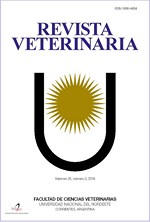Aptitud forrajera de hojas de mandioca (Manihot esculenta) y su aporte nutricional a microsilos de caña de azúcar
DOI:
https://doi.org/10.30972/vet.3024137Palabras clave:
Nutrición del ganado, mandioca, caña de azúcar, ensilaje, aptitud forrajera, productividadResumen
El objetivo de este trabajo fue evaluar la aptitud forrajera de hojas de diferentes cultivares de mandioca y el aporte nutricional a microsilos de caña de azúcar. Los ensayos se efectuaron en Corrientes, Argentina y consistieron en dos experimentos. El primero indagó la productividad y calidad forrajera de hojas de mandioca, para lo cual se caracterizaron siete cultivares (Amarilla, Palomita, Tapó Joá, Rocha, Clon 60, Clon 30 y EC-9) a través de la medición de las variables: retención foliar, biomasa seca, porcentaje de materia seca (MS), de nitrógeno (N), proteína bruta (PB), fósforo (P) y potasio foliar (K). El cultivar Amarilla se destacó por su producción forrajera, la cual alcanzó 23.160 kg de MS/ha, pero presentó sólo 4,62% de PB. Otros cinco cultivares, presentaron menor productividad foliar pero mayor concentración proteica, superior al 11%. El segundo experimento investigó las características nutricionales de microsilos al evaluar dos tratamientos que consistieron en combinar dos proporciones de follaje de mandioca y caña de azúcar: T1 (30% mandioca + 70% caña) y T2 (15% mandioca + 85% caña). En cada tratamiento se hicieron seis unidades de muestreo, de las cuales tres fueron evaluadas a los 30 días y las restantes a los 60 días de ensilado (dde), determinándose en cada instancia: pH, %MS, N, PB, fibra detergente neutra (FDN) y fibra detergente ácida (FDA). En T1 el pH se estabilizó a los 60 dde y en T2 a los 30 dde. La PB (%) fue significativamente superior en T1 en ambos momentos. Los % de FDA y FDN fueron estables en el tiempo. Las hojas de mandioca demostraron ser un valioso recurso proteico, que puede ensilarse exitosamente para suplementar deficiencias nutricionales de la ganadería del nordeste argentino.
Descargas
Descargas
Publicado
Cómo citar
Número
Sección
Licencia
Derechos de autor 2019 A. M. Burgos, M. Porta, C. M. Hack, M. E. Castelan

Esta obra está bajo una licencia internacional Creative Commons Atribución-NoComercial 4.0.
Política de acceso abierto
Esta revista proporciona un acceso abierto inmediato a su contenido, basado en el principio de que ofrecer al público un acceso libre a las investigaciones ayuda a un mayor intercambio global de conocimiento. La publicación por parte de terceros será autorizada por Revista Veterinaria toda vez que se la reconozca debidamente y en forma explícita como lugar de publicación del original.
Esta obra está bajo una licencia de Creative Commons Reconocimiento-NoComercial 4.0 Internacional (CC BY-NC 4.0)










.jpg)
.jpg)



